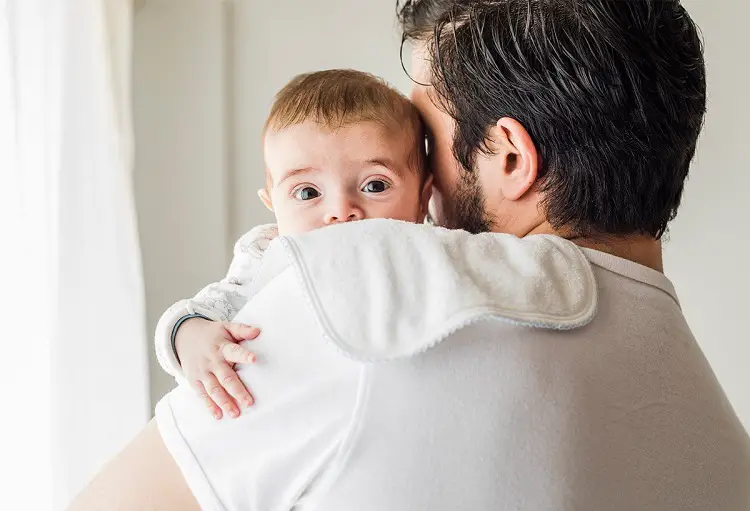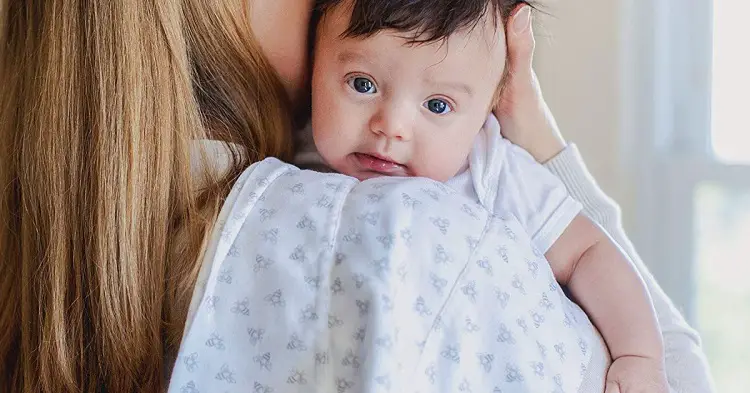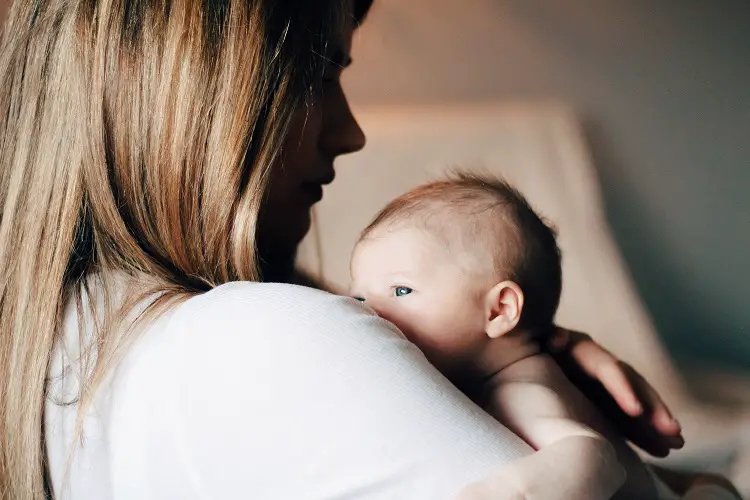Are you thinking of the best ways to burp a baby? Burping is a very important part when feeding your baby. It helps get rid of some of the air that your babies tend to swallow during feeding.
When you do not burp your baby often, there is a chance that your baby might swallow too much air which can make your baby spit up, or seem cranky or gassy.
During nursing, burping should be a key part as it helps allows the baby to remove some of the gassiness to relieve the pain and also prevent spitting up.
In this article, we will be sharing with you the best ways to burp a baby, and practical and positions to bring up the air and make space for the baby’s full meal.
How To Burp Your Baby
The following practical steps will help you burp your baby successfully:
- In between the feed, place your baby on your shoulder, face-down on your lap, or sitting up.
- Protect your favorite clothes by always using a burp cloth or bib between your outfit and the baby’s mouth.
- Give your baby a gentle pat or rub on the left side of his back, which is where your baby’s stomach is located. These practical steps may get the burp up for most babies, but some babies may need a slightly firmer hand.
13 Best Ways To Burp A Baby

Of course, every baby is different. If your baby is restless and the above step fails, here are 13 more ways to get your baby to burp:
1. Over The Shoulder Burp
This technique involves placing your baby gently over your shoulder while patting or rubbing his or her back to take out the trapped air.
Remember that this should be done with a protective layer via a burp cloth. Depending on who practices this approach, though, there can be a slight modification in the approach.
For moms, when doing this, you can lay your baby in a way that positions his or her belly on your breast. This puts a padded layer of pressure on the baby’s tummy to help facilitate release.
For Dads, when doing this, you have to bring your baby a bit higher up so that his/her tummy is resting closer to your shoulder for the same reason. Either way, ensure that you don’t bounce your baby as you burp.
2. Face Down On The Lap
When using this technique, sit on a stable chair or couch with both feet on the ground. Then lay your baby belly-down across your two legs, putting one leg under your baby’s stomach and the other leg under his head, making sure your baby’s head is turned sideways.
Use the burp cloth to avoid the dreaded “wet burp.” Also, use one hand to secure the baby and the other to gently pat or rub his back in a circular motion.
You can also place your baby on your lap, place the heel of your hand under your baby’s ribcage, apply slight pressure and then pat your baby’s back or rub circles with your free hand to enable burping.
3. Sitting Up
While using this technique to burp your baby all you have to do is to make sure that your baby is sitting in an upright position, leaning him or her slightly forward, support the chest and head with one hand and then use the other hand to rub and pat his or her back.
4. Grandmother’s Burp
While using this technique to burp your baby all you have to do is to sit your baby on your lap with the heel of one hand pressed into their stomach and your fingers on either side of their chin to support the baby’s head.
Then you gently run your thumb and forefinger up the baby’s spine so that burping can be achieved.
5. The ‘Old-School’ Burp
When using this technique to burp your baby, ensure that your baby is held in your lap and slightly bent forward at the waist.
Then pat or rub his/her baby’s back, slowly and gently rotating his body back and forth from the waist, as if the baby were doing a pre-aerobic warm-up exercise. Try doing this in each direction, front, back, and sides.
6. Dance Out The Burp
This technique involves holding your baby securely between your two hands, in a sitting position on your knee.
Then gently rotate the top half of your baby’s body gently left to right, and back, in a rhythmic repetitive way. Gently bounce your knee while you do so.
7. Bounce Out The Burp
This burping method works best using an exercise ball. Ensure that you hold your baby close to your chest, with one hand on the baby’s rear and the other one supporting your baby’s neck and head. Then securely sit on your exercise ball and gently bounce up and down.
8. Over The Arm Burp
When using this technique to burp your baby, simply sling your baby over your arm then gently pat his/her back as you pace the room.
9. Knee To Chest Burp
To use this technique to burp your baby, just bend your baby’s knees up against his/her chest and rub or pat his back.
10. Sling Burping
if you want to practice this technique, just place your baby upright against his/her chest and then put the baby in a sling until the air comes up.
This technique helps you do house chores or walk around at the same time. The rhythmic bouncing activities may help relieve gas.
Read Also: How To Use Ring Sling
11. Massage Out The Burp
This is another effective way to burp your baby, just lay your baby’s stomach down with his head tilted to one side on a slight incline.
Then put a little pressure on the spine area and then gently slide one hand up your baby’s back until you reach the shoulder blades. Then use the other hand and place it at the base of your baby’s spine as you massage.
12. Bicycling
To use this technique to burp your baby, gently cycle your baby’s legs toward their chest, just like you pedal a bicycle, while your baby lay on his/her back.
13. Walking
To use this technique to burp your baby, ensure your baby has good head control, and then hold him upright in front of you, facing out, while you stand and walk around.
While walking place one of your hands under his bottom and the other arm across his tummy to add a little pressure. This activity may help give an additional release of any trapped air bubbles.
Read Also: How Many Burp Clothes Do I Need?
When To Burp Your Baby

There are times when you need to burp your baby, and these are keys to effective burping because burping at the wrong time wouldn’t give the desired effects.
Burping When Breastfeeding
This is a good time to burp your baby especially when you are switching breasts. If your baby typically feeds on one breast, burp during the usual “halfway point.” If your baby’s usual feeding session lasts around 20 minutes, then you can also burp at the 10-minute mark.
Burping When Bottle Feeding
You can also burp your baby during bottle feeding but the choice of when to burp during bottle-feeding largely depends on the bottle you’re using. With Dr. Brown’s bottles, you don’t need to burp that often.
Using non-vented bottles or any feeding bottles that can bring in air to build up, burping every 2-3 ounces consumed becomes a safe choice.
Whether you’re bottle-feeding or breastfeeding, after-feeding burping can be very helpful. If your baby has problems with gas, is colicky, or spits up, it is recommended to burp them even more frequently.
Read Also: 11 Newborn Night Feeding Tips To Help You Cope
What Should I Do If My Baby Won’t Burp?
If you’ve tried all the above techniques and your baby is still uncomfortable but won’t burp? You may have to look into changing some of the possible causes that might be causing your baby’s discomfort.
1. Monitor your diet
For breastfeeding moms, try and keep a record of your diet to see what food makes your baby uncomfortable the most, then try and remove the food from your diet and see if the situation improves.
You can also try removing dairy, such as milk, cheese, and ice cream, to see how your baby reacts to it.
2. Formula
Mixing powdered formula into water is usually done by shaking, which usually gets tiny air bubbles into the mix.
When preparing the formula, swirl the formula into the water to minimize air bubbles or allow the formula to rest after shaking, this releases air bubbles.
You can also use pre-mixed formula, but before you do make sure to consult with your pediatrician if you are thinking about changing the formula.
3. Nipples
Several nipple alternatives span all through baby ages while growing from (preemie, newborn, 3-6 months, 6+ months, etc.).
If a nipple is too big your baby may be at risk of swallowing them too quickly, letting air in as they try to keep up with the large flow. Always choose the right size for your baby for the best feeding experience.
4. Bottles
Some baby feeding bottles are designed to occupy as little air as possible. We also have disposable liners, vents, or straw-like systems that can also help keep bubbles away from getting into the baby’s system as they feed.
5. Medication
Over-the-counter medication (Simethicone gas drops) such as Mylicon or Little tummy’s gas relief drops are a good alternative to try for a baby suffering from gas.
Scientific research has shown gas drops to be no more effective than a sweet-flavored placebo.
6. Gripe water
Gripe water usually includes a mix of chamomile, dill, ginger, or peppermint all these are stomach-calming herbs.
Some of it also contains sodium bicarbonate. Try and choose alcohol- and sugar-free version, and watch the dosing and see if it contains sodium bicarbonate.
Read Also: How To Make Gripe Water For Baby At Home
Why Do You need To Burp Baby?
It’s very important to burp the baby after each feeding, even if he’s sleeping. When your baby feeds, he/she can’t help but take in a little air along with her breast milk or formula.
More so, having those little air trapped in his tummy can make him very uncomfortable and full before he’s finished eating.
This is why burping your baby to take out any excess air is such an important thing to do during any feeding process.
If your baby is fussy during feeding due to this discomfort, it’ll also cause him to take in more air and this can lead to more belly discomfort and possibly spitting up.
If your baby starts feeling unsettled during feeding, try burping baby him/her right away to see if it’s an air bubble in his tummy that’s causing the distress.
Read Also: What Are The Best Baby Burp Cloths?
Other Burping Related Questions
Can You Burp Babies After Breastfeeding?
As you should know, not all babies need to be burped. Babies with reflux or colic may need to be burp regularly, others babies may have no issues with gas and can fall asleep at the breast or bottle with ease.
According to the AAP (American Academy of Pediatrics), breastfed babies often need less burping because they swallow less air than bottle feeders.
A research study published in Child: Care, Health, and Development, in the year 2015 say that burping may not be needed in babies and may result in more spit-up.
What Happens If I Don’t Burp My Baby?
So your baby happens to sleep off before you could give him a good pat on the back? The good news is burping a baby can help relieve excessive gas, but as we stated earlier, not all babies need to be burped.
Normally, during breastfeeding babies often swallow less air and, therefore, may not need to be burped after each feed.
If your baby falls asleep comfortably without burping after feeding, then you’re lucky! If your baby is extra unease or squirmy after you’ve finished nursing, then he may have excess gas and may need to be burped.
When Can I Stop Burping Baby?
You can stop burping your baby after two months, at this time your baby is more likely to burp readily on his/her own.
Babies at age four to six months old have more robust neck and stomach muscles these prevent them from taking in excess air.
Hence, if your baby is fussy and gassy, continue burping and using other gas-relief options or talk to your baby doctor.
Read Also: What Happens if Baby Drinks Too Much Milk
Conclusion
We hope this article has given you indebt knowledge on the best ways to burp a baby. As a parent, it’s your responsibility to ensure you take good care of your baby, try out any of the techniques mentioned above, and see which method suits you and your baby.
